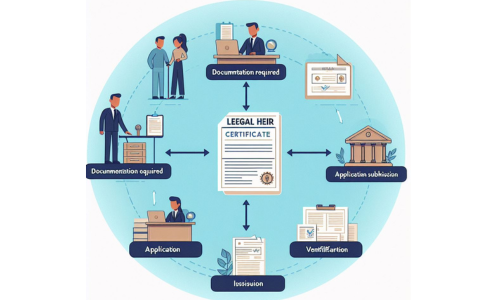Introduction
In today's interconnected world, Non-Resident Indians (NRIs) often deal with legal matters in India. One important document they might need is the Legal Heirship Certificate-a crucial proof that establishes who rightfully inherits a person's assets. This guide provides NRIs with a detailed walkthrough of the steps and requirements for obtaining a Legal Heirship Certificate.

1. Understanding the Legal Heirship Certificate
Before we dive into the process, let's understand what a Legal Heirship Certificate is. This document acts as a legal endorsement that identifies who should inherit a deceased person's assets and responsibilities. NRIs typically need this certificate to claim their inheritance, manage properties, or handle other legal matters in their home country. It is essential for settling disputes and ensuring that the deceased's estate is distributed according to the law.

2. Eligibility Criteria for NRIs
As NRIs deal with administration, it's important to know the eligibility criteria for getting a Legal Heirship Certificate. Generally, immediate family members like spouses, children, and parents are considered legal heirs. However, for NRIs, the process might be different, requiring a careful examination of personal and family details.
To initiate the application, NRIs must provide proof of their relationship with the deceased. This can include marriage certificates, birth certificates, or other legally recognized documents. Clear and verifiable communication is crucial due to geographical restrictions. In some cases, NRIs might need to appoint a local representative to manage the process on their behalf, ensuring that all formalities are properly completed.

3. Documentation Required for NRI Legal Heirship Certificate
Obtaining a Legal Heirship Certificate involves dealing with a lot of paperwork. NRIs should be prepared with a set of documents to streamline the process. Essential documents include:
1. Death Certificate of the Deceased: This is crucial evidence to initiate the legal heirship process.
2. Proof of Relationship: NRIs need to provide documents that establish their relationship with the deceased, such as marriage certificates, birth certificates, or legally recognized family records.
3. Address Proof: Valid address proof is necessary to establish the NRI's identity and residence.
4. Passport and Visa Copies: NRIs must submit copies of their passport and visa to prove their NRI status.
Self-Declaration: A self-declaration affirming the NRI's relationship with the deceased and their status as a legal heir.
Navigating the documentation maze requires precision and attention to detail, ensuring a smooth application process.

4. Application Procedure for NRIs
With the groundwork laid, NRIs can now proceed to the application stage, involving a systematic approach and adherence to legal protocols.
1. Initiating the Application
NRIs can start the application process by contacting the local jurisdictional authority where the deceased resided. This might involve the local municipal office or the district collector's office, depending on regional regulations. In some instances, NRIs may need to engage a lawyer who specializes in inheritance law to guide them through the process.
2. Submission of Documents
Once the application is initiated, NRIs must carefully submit all required documents. Timely and accurate submission significantly speeds up the processing time. It is advisable to keep multiple copies of all documents and ensure that each document is attested by the appropriate authority to avoid delays.
3. Legal Verification
Authorities will conduct a thorough verification process to ensure the authenticity of the submitted documents. This step is crucial for maintaining the integrity of the legal heirship certification process. During this stage, authorities may reach out to the NRI or their local representative for additional information or clarification.
4. Publication of Notice
In many jurisdictions, a public notice is published to invite objections or claims against the legal heirship application. This is a critical step that allows any potential disputes to be addressed before the certificate is issued. NRIs should closely monitor this stage, as objections raised may require legal resolutions.
Conclusion
Getting a Legal Heirship Certificate as an NRI involves a multi-step process, including eligibility verification, meticulous documentation, and a systematic application procedure. Navigating administrative intricacies demands patience and adherence to legal protocols. As NRIs work to secure their rightful inheritance, this guide aims to empower them with the knowledge needed to navigate the legal landscape effectively.
The author is a Chartered Accountant and former EY employee, serves as the Chief Consultant of the NRI Desk and Influencer Desk at AKT Associates. He specializes in offering consultancy services tailored for NRIs and is dedicated to creating educational content to raise awareness within the NRI community.







 CAclubindia
CAclubindia

